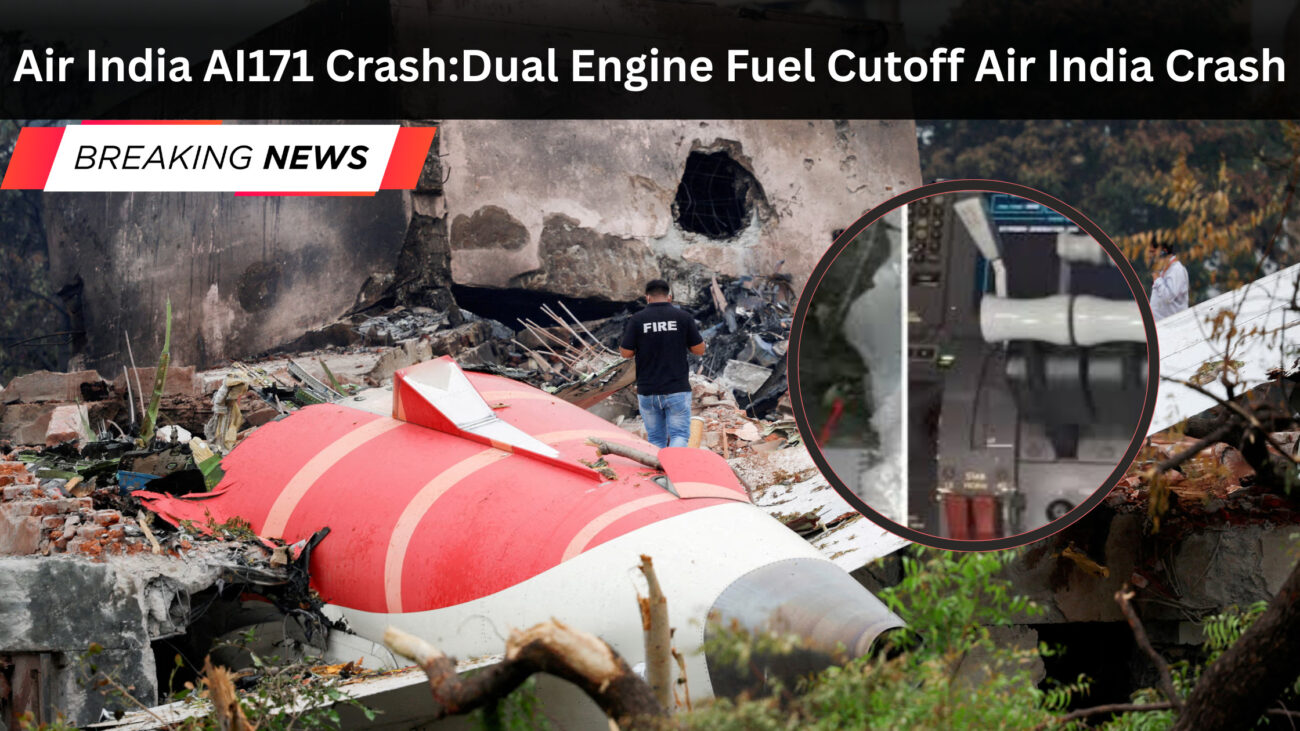In a heartbreaking incident, Air India AI171 Crash, which was flying a Boeing 787-8 Dreamliner, tragically crashed just moments after taking off from Ahmedabad’s Sardar Vallabhbhai Patel International Airport on June 12, 2025. The flight was en route to London Gatwick but met a devastating fate, leading to the loss of 260 lives. On July 11, 2025, the Aircraft Accident Investigation Bureau (AAIB) shared its initial findings, highlighting concerning cockpit confusion and a sudden failure of both engines.
Table of Contents
Air India Crash report India: Routine Takeoff Ends in Disaster
According to the straightforward Air India Crash report from the AAIB, the flight took off at 08:08:39 UTC, and everything seemed normal with the engine parameters. However, just three seconds later, disaster struck. Both engines lost their fuel supply when the fuel control levers unexpectedly switched from RUN to CUTOFF, causing the Boeing 787-8 to enter a perilous stall. This sudden dual engine fuel cutoff scenario during takeoff is not only rare but also incredibly dangerous, especially during such a critical phase of flight.
Aircraft Cockpit Confusion Incident: What the Pilots Said
The Cockpit Voice Recorder (CVR) captured a haunting exchange between the pilots just moments after the engine failure:
- Captain: “Why did you cut off?”
- Co-Pilot: “I didn’t do that.”
This incident of confusion in the cockpit is a significant concern highlighted in the Air India crash report. Neither pilot could clarify how both engines went silent, suggesting a possible systems failure or a mistake on their part.
This kind of confusion during such a critical time cost the crew precious seconds to react, making a successful recovery even less likely.
Dual Engine Fuel Cutoff Air India Crash: Findings from AAIB Report
A recent investigation by the Air Accidents Investigation Branch (AAIB) has revealed a troubling technical failure that resulted in the heartbreaking crash of Air India flight AI171. According to the preliminary crash report that India is currently reviewing, both engines of the Boeing 787-8 aircraft unexpectedly shut down mid-flight due to an uncommanded fuel cutoff—an unusual and concerning event.
Key Findings from Air India AI171 Crash
- Both engines went silent almost at the same time while in the air, creating a serious emergency situation.
- The fuel cutoff switches, which control the flow of fuel, flipped from ‘RUN’ to ‘CUTOFF’ in just a second.
- This automatic shutdown triggered the deployment of the Ram Air Turbine (RAT), a backup system designed for emergencies.
- After the engines stopped, the aircraft started to lose altitude quickly, unable to stay in powered flight.
- The reason for this dual engine fuel cutoff Air India crash is still unknown, and investigators are yet to determine whether it was caused by a system malfunction, software error, or another unidentified trigger.
This part of the Air India crash report has sparked a lot of questions in the aviation community. We’re still waiting for the final verdict, as experts are diving deep into what went wrong during that tragic flight.
Aircraft Cockpit Confusion Incident: Deepens Over Unexpected Shutdown
The confusion in the aircraft cockpit adds another layer of complexity to the Air India crash. The cockpit voice recorder picked up a puzzling exchange between the two pilots. One pilot asked, “Why did you cut off?”, and the other responded, “I did not do so.” This conversation suggests that one pilot noticed the sudden engine shutdown and was looking for answers, while the other denied making any such action.
he AAIB report is still digging into whether this was a case of human error or a technical malfunction that led to this tragic failure in mid-air.
Air India Crash Report 2025: No Blame on Boeing or GE Yet, Says AAIB
According to the most recent report on the Air India crash, the Air Accidents Investigation Branch (AAIB) has chosen not to directly blame either Boeing, the aircraft manufacturer, or General Electric (GE), the engine maker, for the dual engine fuel cutoff that led to the crash of flight AI171.
Key Points from the Report:
- The aircraft in question was a Boeing 787-8 Dreamliner, powered by GE GEnx-1B engines.
- According to the preliminary crash report from India, there’s been no indication of any manufacturing or operational issues linked to Boeing or GE at this point.
- So far, the AAIB hasn’t recommended any technical directives or safety advisories for operators of the 787-8.
- These findings come at a time when Boeing’s safety practices are under intense global scrutiny, raising concerns among the public and industry alike.
- In a carefully crafted statement, Boeing mentioned that it will follow the AAIB’s lead in accordance with ICAO’s Annex 13 international protocol regarding air crash investigations.
Manufacturer Response Table On Air India Crash report
| Entity | Role | Current Status (As per AAIB) | Official Statement |
|---|---|---|---|
| Boeing | Aircraft Manufacturer (B787-8 Dreamliner) | No fault assigned; No regulatory action taken | “We will defer to the AAIB to provide information about AI171, per ICAO Annex 13.” |
| General Electric | Engine Manufacturer (GE GEnx-1B engines) | No fault assigned; No regulatory action taken | No independent statement; covered under current AAIB report |
The aviation industry and regulatory agencies around the globe are keeping a close eye on the findings from the Air India crash report, as this situation continues to unfold. The decision on any future actions will hinge entirely on further technical assessments and solid evidence.
Conclusion
The Air India AI171 crash isn’t just a story about a system failing; it’s also about how communication fell apart, design issues came to light, and crucial recovery opportunities were overlooked. As the investigation unfolds, it’s set to shape global aviation policies and highlight the critical need for fail-safe flight protocols.
The preliminary report from the AAIB is merely the starting point for a much larger conversation about flight safety, the interaction between humans and machines, and how dependable automated systems are in commercial aviation.

